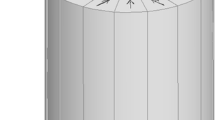Abstract
The main magnetic fields of mobile nuclear magnetic resonance (NMR) magnets differ from those of conventional NMR and magnetic resonance imaging (MRI) magnets. In the Halbach magnet, the main field B 0 is perpendicular to the longitudinal axis, the symmetry of the current distribution with respect to the symmetry of the magnetic field differs from that in conventional target-field applications, and the current distribution on the coil surface cannot be expressed in terms of periodic basis functions. To obtain the winding pattern of the coil, an efficacious target-field approach. The surface of a coil is divided into small discrete elements, where each element is represented by a magnetic dipole. From the stream function of the elements, the resultant magnetic field is calculated. The optimization strategy follows an objective function defined by the power dissipation or efficiency of the coil. This leads to the optimum stream function on the coil surface, whose contour lines define the winding patterns of the coil. This paper shows winding patterns designed of shim coils for Halbach magnet and illustrates the craft of a shim coil using flexible printed circuit board. The performance of the coils is verified by simulating the fields they produce over the sensitive volume.






Similar content being viewed by others
References
B. Blümich, NMR Imaging of Materials (Clarendon, Oxford, 2000)
K. Halbach, IEEE Trans. Nucl. Sci. 26(3), 3882–3884 (1979)
K. Halbach, Nucl. Instrum. Meth. 169, 1–10 (1980)
H. Raich, P. Bluemler, Concepts Magn. Reson. Part B 23(1), 16–25 (2004)
E. Danieli, J. Mauler, J. Perlo, B. Blümich, F. Casanova, J. Magn. Reson. 198, 80–87 (2009)
R.C. Jachmann, Rev. Sci. Instrum. 78, 035115 (2007)
F. Romeo, D.I. Hoult, Magn. Reson. Med. 1, 44–65 (1984)
R. Turner, J. Phys. D Appl. Phys. 19, L147–L151 (1986)
R. Bowtell, P. Mansfield, Meas. Sci. Technol. 1, 431–439 (1990)
D. Tomasi, Magn. Reson. Med. 45, 505–512 (2001)
M.A. Brideson, L.K. Forbes, S. Crozier, Concepts Magn. Reson. 14, 9–18 (2002)
L.K. Forbes, S. Crozier, J. Phys. D Appl. Phys. 34, 3447–3455 (2001)
L.K. Forbes, S. Crozier, IEEE Trans. Magn. 40, 1929–1938 (2004)
S.E. Ungersma, H. Xu, B.A. Chronik, G.C. Scott, A. Macovski, S.M. Conolly, Magn. Reson. Med. 52, 619–627 (2004)
W. Liu, D. Zu, X. Tang, Chin. Phys. B 19, 018701 (2010)
W. Liu, X. Tang, D. Zu, Concepts Magn. Reson. Part B 37, 29–38 (2010)
M. Poole, R. Bowtell, Concepts Magn. Reson. Part B 31, 162–175 (2007)
H. Lopez, F. Liu, M. Poole, S. Crozier, IEEE Trans. Magn. 45, 767–775 (2009)
B.A. Chronik, B.K. Rutt, Magn. Reson. Med. 39, 270–278 (1998)
H. Liu, C. Truwit, IEEE Trans. Med. Imag. 17, 826–830 (1998)
Acknowledgments
This work was supported by China Scholarship Council (CSC) and the Natural Science Foundation of China (NSFC No.60871001).
Author information
Authors and Affiliations
Corresponding author
Rights and permissions
About this article
Cite this article
Liu, W., Casanova, F., Blümich, B. et al. An Efficacious Target-Field Approach to Design Shim Coils for Halbach Magnet of Mobile NMR Sensors. Appl Magn Reson 42, 101–112 (2012). https://doi.org/10.1007/s00723-011-0260-2
Received:
Published:
Issue Date:
DOI: https://doi.org/10.1007/s00723-011-0260-2




